
Back in 1781, Mozart wandered into Vienna’s Deutschordenshaus, where his boss (the Archbishop of Salzburg) was staying, argued a little a lot, and eventually got fired.
He decided to stay in the city as a freelance composer, musician, and teacher. And so a legendary partnership began…Mozart and Vienna, which go together like Beethoven and Vienna. Or Schubert and…, well, you get the message.
- Book a concert experience* in Vienna
- See also:
Use the below photos, notes, links, map, and more for a Mozartean meander through the streets of Vienna to the places he lived and performed in, and to the many memorials to his genius.
A couple of bonus suggestions:
- Should you wish to hear Mozart’s music played live in historical surrounds, try these concert tips.
- Mozart’s birthplace (Salzburg) is a relatively simple day trip away from Vienna and has its own musical landmarks for visitors.
Jump to Mozart locations related to his…
Mozart: his life
The building on Domgasse 5 right in the heart of the city should probably be your first address, since it houses the Mozarthaus and the Mozart apartment. Although technically two separate institutions, they both share a single ticket, entrance, and location.
Mozarthaus
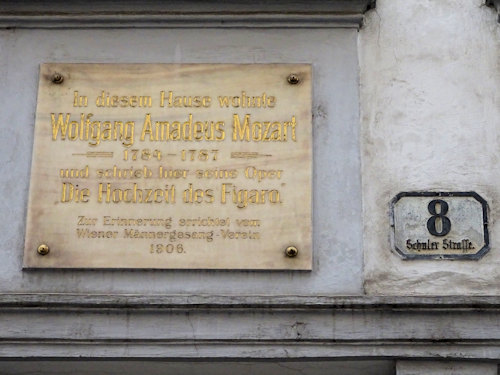
(Plaque outside the building)
The Mozarthaus museum covers the composer’s time in Vienna and his music, with a changing bonus exhibition, too. It occupies two floors above the Mozartwohnung (see below).
A concert venue in the basement also features regular performances of classical works, including those composed at the same location by Mozart himself.
Mozartwohnung
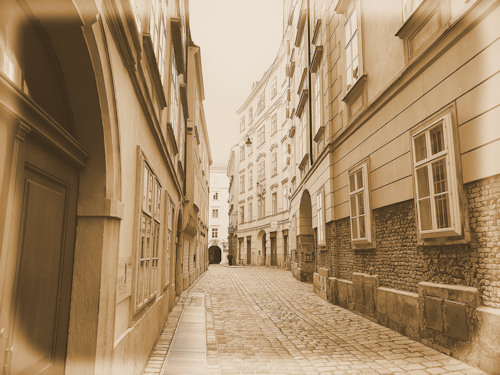
(The historical street outside in 2023, barely changed across the decades and given a sepia touch to prove the point)
Take a trip around the actual apartment Mozart and his family lived in between 1784 and 1787. He wrote The Marriage of Figaro in this residence, for example, and entertained the likes of Haydn.
The area around Domgasse looks pretty much like it did in the late 1700s, and I’d recommend taking a few minutes just to wander around the local backstreets for a flavour of old Vienna away from the crowds.
Other homes
Mozart moved around a lot. I suspect for financial reasons, but let’s prefer to think it reflects his musical philosophy, as espoused in a letter to his father in 1778:
A fellow of mediocre talent will remain a mediocrity, whether he travels or not; but one of superior talent (which without impiety I cannot deny that I possess) will go to seed if he always remains in the same place
The Mozartwohnung remains the only one of Mozart’s residences that is more or less unchanged. Many have been destroyed, others altered beyond recognition. These are the ones I think are still the same building (but no promises!).
Weihburggasse 3

(A hotel with history)
Mozart lived here on a visit to Vienna in the autumn of 1767. It’s now the Hotel Kaiserin Elisabeth. Other prominent musical guests to grace the corridors of the building include Franz Liszt, Richard Wagner, Anton Bruckner, and Eduard Grieg.
Tiefer Graben 18
Mozart stayed here for about three months on another visit to Vienna with his father. Here he wrote, for example, the incidental music to Thamos, King of Egypt. A plaque outside the building, which is now the Hotel Das Tigra, commemorates the stay.
Deutschordenshaus
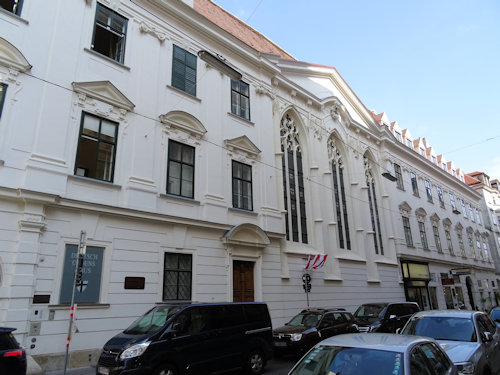
(Once home to Brahms, too)
The Deutschordenshaus hosted Mozart in 1781 while he was still in service to the Archbishop of Salzburg. This is where the quarrels took place that led to his eventual dismissal and decision to go solo in Vienna. (Luckily for us.)
A few years later and Mozart would be living in a rather fine apartment (the Mozartwohnung mentioned earlier) within shouting distance of these old quarters.
A famous composer might be considered a fine thing for a building’s history. Two is almost greedy; Johannes Brahms lived at this address in the early 1860s.
Milchgasse 1

(The style of the surrounding building suggests it might be too young to be the original. I’m not sure)
The composer’s first address after leaving the Archbishop’s service. A plaque outside the house says he lived in the building and wrote Die Entführung aus dem Serail there.
Kohlmarkt 7
Mozart apparently lived here for a few weeks in 1783. It’s a remarkably handy address for the Habsburg Palace complex (almost next door).
Judenplatz 3-4
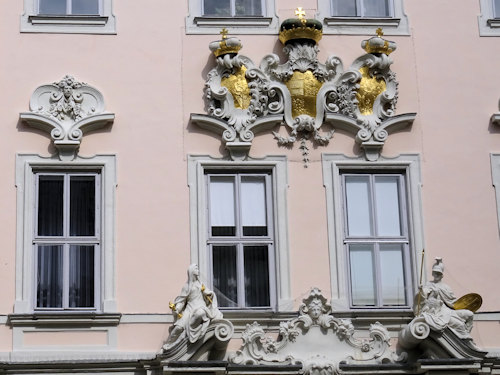
(The view from Mozart’s Judenplatz residence)
The original building is no more, but a nice plaque put up by the innkeeper’s cooperative in 1929 mentions Mozart living here in 1783.
The location now houses the restauranteur section of the Viennese Chamber of Commerce. The building across the square is still from Mozart’s time.
Währinger Straße 26
Not the original building, but a plaque above the entrance describes how Mozart wrote Cosi fan tutte and other pieces in the “Garden House” on this site around 1788.
Rauhensteingasse 8
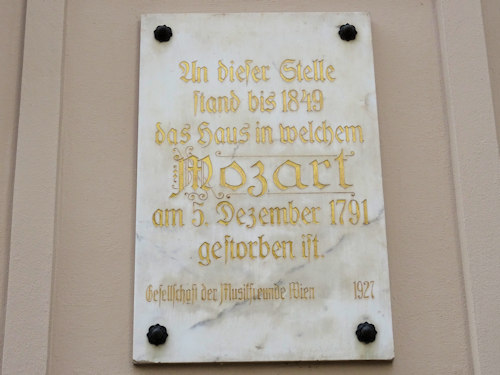
(A plaque commemorates the location where Mozart passed away)
Another building long gone, but this is the address where Mozart died. The current house still has the words “Mozarthof” inscribed above the doorway, and a memorial plaque from the 1920s hangs on an outside wall.
The same block now has the Mythos Mozart interactive experience (see below).
Stephansdom cathedral
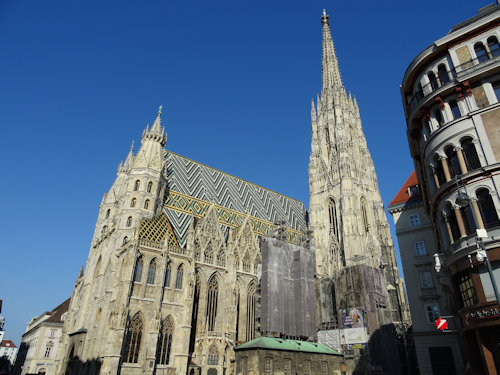
(The cathedral is gothic, the famous mosaic roof rather newer)
St Stephen’s cathedral (Stephansdom in German) really fulfilled the “births, deaths and marriages” role when it came to Mozart.
Two of his children were baptised here. On his death, his body was blessed here and a requiem held. And he married Constanze Weber here on August 4th, 1782.
A plaque on the wall inside the cathedral commemorates all these events (on the south side, next to the Katharinenkapelle).
Mozart’s grave
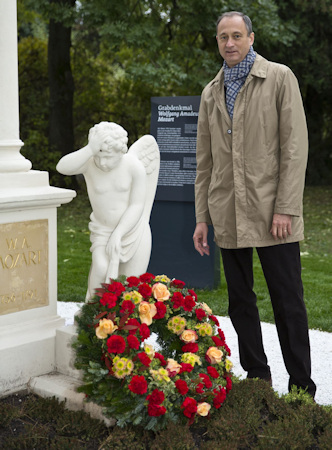
(City councillor, Mr Mailath-Pokorny, at the newly-restored Mozart grave. Photo © PID / Georg Oberweger)
Contrary to legend, they did not dump Mozart in some pauper’s mass grave, but it was an unmarked one. A memorial marks the grave’s most likely location in St. Marx cemetery. More details here.
Michaelerkirche
St. Michael’s church held a requiem for Mozart on December 10th, 1791. The occasion also saw the premiere of the completed parts of his Requiem in D Minor. Bronze reliefs inside commemorate the occasion.
Mozart: his music
As with the residences, most venues fell victim to the ravages of time, war, and urban planners.
Many of the beautiful 19th-century buildings you see in Vienna were only made possible by tearing down the beautiful 18th- and 17th-century buildings that came before them.
Schönbrunn Palace and Orangery
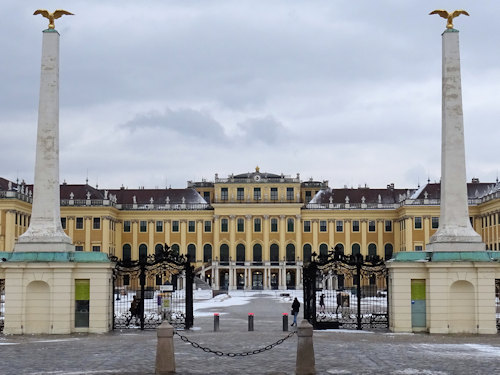
(The main entrance to the palace complex)
The summer palace of the Habsburgs witnessed a couple of legendary Mozart moments.
On the palace tour, you see the room where a young Mozart first performed for Empress Maria Theresa. And a famous royal wedding painting features the composer as a young boy, even though he was never there.
In the Orangery (which still holds public concerts), Mozart and Salieri duelled it out musically at the behest of Emperor Joseph II.
Salieri’s Italian opera went up against Mozart’s German Singspiel, both competing for the attention of the assembled guests.
(Incidentally, Salieri won.)
Palais Collalto

(The building dates back to the late 17th century)
A plaque outside reveals that Mozart gave his very first public performance in Vienna in this Palais in 1762 (he must have been about seven years old).
Waisenhauskirche
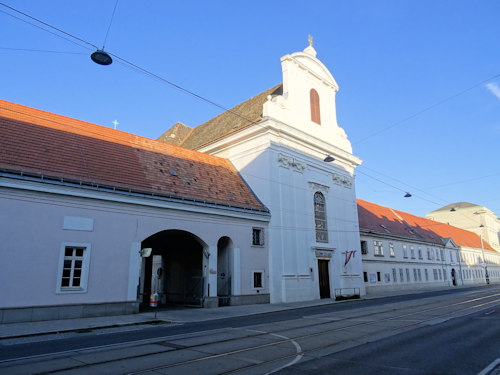
(Another historical complex still going today)
A 12-year-old Mozart wrote the Mass in C minor (the “Waisenhausmesse”) for this church’s consecration in 1768 and led the performance himself. Formerly serving an orphanage, the Waisenhauskirche has become the Parish Church “Maria Geburt”.
Augartensaal
This proved a regular venue for entertainments in the Augarten park in the late 18th and early 19th century. Mozart performed his Piano Concerto No. 10 in the Augartensaal in 1782, as a plaque outside reveals.
Schubert and Beethoven both performed pieces at this location too.
Himmelpfortgasse 6

(Note the plaque to the left of the doorway)
A plaque outside Café Frauenhuber explains that Mozart performed a piece of pastoral music by Handel in this building in 1788 (Beethoven popped in in 1797). You can go inside the coffee house, of course, which first opened in 1824.
Palais Auersperg
Mozart (probably) led a performance of his Idomeneo opera here in 1786. This Baroque palace is a popular venue for exhibitions, fairs etc. and still hosts classical music concerts.
Mozart: memorials & more
Mythos Mozart
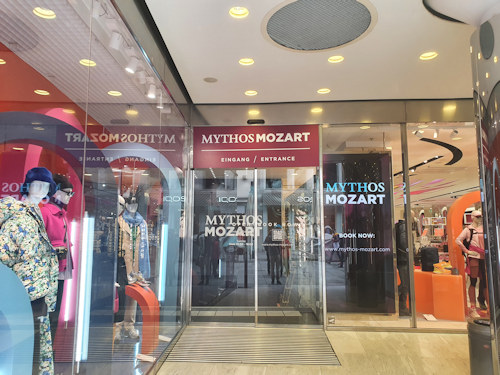
(Located below a major department store in the city centre)
Immerse yourself in a world of Mozart’s music with an intense and memorable five-room audiovisual experience.
Mythos Mozart combines art, music, animation, projections, interactivity and even AI-driven data sculptures to create a rather mesmerising journey. I thoroughly enjoyed it.
The Mozart monument

(The monument prior to its 2022 renovation)
They unveiled this large statue in 1896 and moved it to the Burggarten park in 1953. The Mozart monument remains one of Vienna’s best-loved photo motifs, thanks in part to the musical symbol written out in flowers in front of it.
Zentralfriedhof memorial
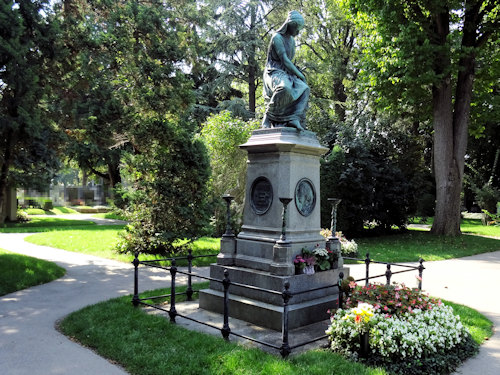
(Not Mozart’s grave, whatever it may look like!)
The Zentralfriedhof cemetery has a group of famous composers buried there (Beethoven, Schubert, Brahms, various members of the Strauss family, and others).
The Mozart memorial there is just that: a memorial and not Mozart’s actual grave. They moved it to the Zentralfriedhof in 1891 from the supposed site of Mozart’s St. Marx burial location.
Haus der Musik

(Other composers featured within include Beethoven, Haydn, Mahler, Strauss (II) and Schubert)
Vienna’s House of Music has memorabilia-filled rooms dedicated to individual composers associated with the city. Mozart has one where you can, for example, see how he would have put your name to music.
Minor sites
To end…some suggestions for the truly dedicated collector of Mozart memories.
Café Mozart
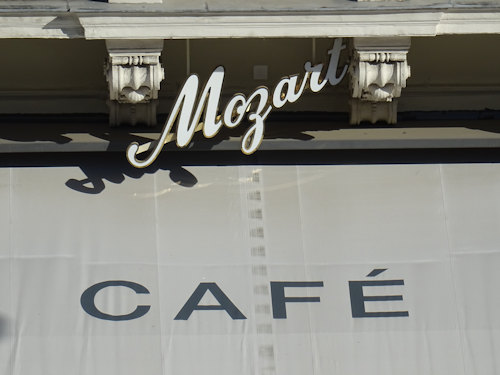
(One of Vienna’s traditional cafés)
The first coffee house on this spot dates back to 1794. Café Mozart received its current name in 1929, in honour of the Mozart monument then located opposite (and now in the Burggarten).
Maria Theresa monument
Marie-Theresien-Platz has a monument put up in 1888 to honour the great Empress of the 18th century.
One side of the huge plinth highlights personalities from science and art: a statue of a young Mozart stands just below Haydn.
The Mozart fountain
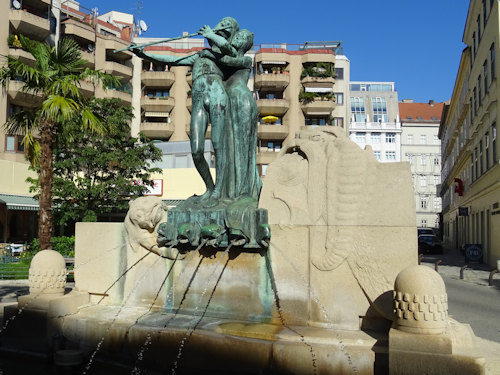
(An example of Jugendstil architecture)
A fountain built in 1905 and also known as the Magic Flute fountain, since it depicts a scene from the opera. It sits on a small square (Mozartplatz) on Mozartgasse, both renamed for the composer.
Minoritenkirche
A memorial to the famous Italian poet, Pietro Metastasio, inside this Gothic church features Mozart on its central relief.
Papagenotor
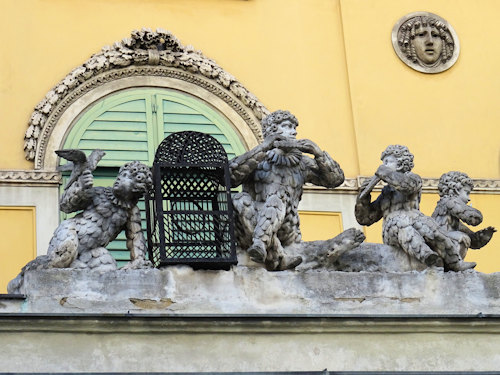
(Stone figures above a gateway show Papageno from The Magic Flute)
The Papagenotor gate honours Emanuel Schikaneder, who wrote the libretto to The Magic Flute and also founded the Theater an der Wien concert/opera house the gateway leads into.
Various streets in Vienna bear the name of characters from the same opera: Paminagasse, Taminoweg, Sarastroweg, and Papagenogasse.
Madame Tussauds
Nip into the famous wax museum and grab a selfie with Wolfgang (and many other famous composers associated with Vienna).
Mozart location map
All the locations described above are shown on the map below, with a few extras.
Places I’ve found where Mozart lived or performed only appear on the map if the original building still exists or if there is a plaque or similar there to see.
I’ll add more locations as I find and research them.